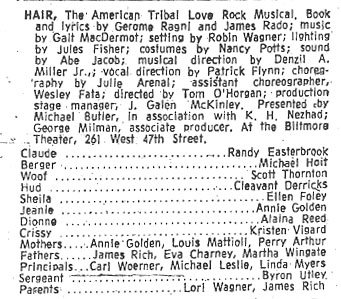 Editors
Note: To see the differences between
this cast list and the cast list in the Preview Playbill from approximately
one month earlier click
here.
Editors
Note: To see the differences between
this cast list and the cast list in the Preview Playbill from approximately
one month earlier click
here.
To see the photo that originally accompanied this article
click
here.
Nothing ages worse than graffiti. Hair, the hippie musical, was a raffish slogan scrawled in day-glow upon the institutional walls of the late 1960s.
Its message - liberation, joy, pot and multiform sex, the vision of youth as a social class of its own and, in short, the notion that there can be flowers without stalks, roots or muck to grow in - has faded.
It is too far gone to be timely; too recently gone to be history or even nostalgia. It's revival at the Biltmore Theatre has no particular occasion to it, and so it must stand or fall quite badly upon its merits.
It falls, or rather, it sags. Its virtues remain, but 10 years after its first appearance they look much feebler than they must have seemed at the time. Its glow is forced; its warmth become sentimentality and worse, sententiousness. Over and over one is reminded of the worst kind of religious art: the simpering or soulful hippies recall the simpering plaster Virgins and soulful Christs sold around shrines.
Even before it starts it is clear that the audience is to be the object of a great deal of planned spontaneity. Robin Wagner's set, pyramided and festooned with laundry, a jukebox, carvings, love-signs, is on display, and so is the cast.
The young actors, in beads and tie-dyed regalia, prowl the aisles calling out cheerfully to each other, standing on the seats and chatting with he arriving spectators. Even after the show began the audience was never neglected: at one point Michael Holt, the male lead, hurled himself with a cry of "Mother!" onto the lap of the critic from the Wall Street Journal.
"Aquarius," the first number, is still attractive as a song. Visually, with the actors rousing and waving their arms slowly like a dawn scene in a jungle, it is pretty enough for a while. But a feeling of over-production, of over-elaborateness, creeps in.
There is something familiar about the spectacle, with a girl bearing an incense pot, and the actors undulating into a frieze. It is, in fact, oddly like some of the Caribbean voodoo numbers that used to be put on with staged exoticism at the Tropicana nightclub in Havana for the benefit of American tourists and, later, EAst European technicians.
Other curious associations intrude. Some of the loving smiling done by the cast is not all that different from the classic teeth-baring of the old-fashioned chorus line. A rousing, stomping episode with placards bearing antiwar slogans and denouncing L.B.J. has something of the old-battles-refought quality of an American Legion reunion.
When Michael Holt, as Berger, bares his buttocks, the brave symbolism of the act has departed, and we are left only with the reflection that pants are in fact an older and sturdier human tradition than pantlessness. When the American flag is displayed in various playful manners, the thought occurs that flag-mockery is a more limited and perhaps a less generally useful symbol than flags.
Julie Arenal's choreography is lively and often stirring. In one of the first numbers, "Donna", the entire cast begins jiggling and bouncing while sitting on the floor and, in their woolen wrappings, they resemble 24 bedbugs doing a jig under a blanket. "Aint Got No," is a marvel of pinwheeling arms and legs.
Eventually, though, the effect is of movement for movement's sake. It is too much; exuberance attacks too frequently and at the end of two and a half hours it is a surfeit.
By and large, the skits are poorer than the songs. A scene where six stuffy parents with false mustaches and false bosoms urge the benefits of jobs, television and plastic flowers on their hippy son is painfully long and obvious. Tom O'Horgan who directed this production, as he did the original - the production staff as a whole is virtually unchanged - allows this and other numbers to drag on and on.
Some of the songs hold up very well. "What A Piece Of Work Is Man," with two high voices singing the Shakespeare text in close harmony against a rhythmic counterpoint, is sheerly beautiful. Unfortunately it is intended as poignant commentary upon a scene in which all the young flowers have been mowed down and lie dead and which seems purely stagey.
One of the finest survivors is "Air," a bouncing and silvery commentary on pollution sung by Iris Rosencrantz and Kristin Vigard. The very best song of all, and perhaps the best performance as well, is Miss Vigard in the stony and touching saga of a teenybopper, "Frank Mills." Miss Vigard looks like an ancient 12 year old; she sings in a clear, clean style that cuts most satisfyingly through the general lushness.
Of the rest of the cast, Mr. Holt is agile and goofily commanding as Berger. Cleavant Derricks is funny and explosive as the short but vigorous black lead. Randall Easterbrook is less satisfactory as Claude. He is bland and excessively soulful, but then of all the characters Claude by now seems the least sufferable. His part calls for saintly attitudes to the point where we wish somebody would drop a guitar upon him.
 Editors
Note: To see the differences between
this cast list and the cast list in the Preview Playbill from approximately
one month earlier click
here.
Editors
Note: To see the differences between
this cast list and the cast list in the Preview Playbill from approximately
one month earlier click
here.
Copyright The New York Times Company. All rights
reserved.